Cacoo templates every dev team should bookmark
Georgina Guthrie
November 07, 2025
Whether you’re diagramming software architecture or drafting a new ER model, having a clear diagram makes all the difference. But starting from a blank page every time is a headache most dev teams don’t have time for.
With ready-made templates, cloud sharing, and a handy drag-and-drop interface, Cacoo helps you transform ideas into shareable diagrams in minutes.
In this guide, we’ll walk you through the best Cacoo templates for development teams — plus how to adapt them for your specific workflow and goals.
Why development teams use Cacoo
Cacoo gives you the tools to work faster and collaborate better. It’s built for:
- Rapid prototyping with drag-and-drop elements and reusable templates
- Real-time collaboration with team members and stakeholders
- Integration-ready visuals that slot neatly into technical documentation or presentations.
Plus, with version control, custom templates, and cloud sync, your diagrams stay accessible, accurate, and easy to update every step of the way.
Top templates for development teams
Cacoo offers hundreds of diagram templates — but for developers, a few stand out as time-savers you’ll want to bookmark.
1. Architecture & infrastructure diagrams
When planning or documenting systems, these templates are essential:
- Component diagram – Ideal for mapping modular application components and their interdependencies.
- Deployment diagram – Shows how software components are deployed to hardware or cloud environments.
- Kubernetes architecture diagram – Quickly map your clusters, nodes, pods, and services.
- AWS architecture diagram and AWS network diagram – Use standardized AWS icons to design or explain your cloud infrastructure.
- Azure deployment diagram / Azure web monitoring diagram – Great for teams using Microsoft’s cloud tools.
- Google cloud architecture diagram – Illustrate GCP deployments and networking with ease.
- Oracle cloud infrastructure – Purpose-built for teams using OCI for backend systems.
- HPC architecture diagram – For visualizing high-performance computing environments.
- Bus topology / Network diagram / Computer network diagram – Great for physical or virtual network mapping.
Pro tip: Use the Azure ecommerce diagram or Azure personalization diagram for industry-specific inspiration — both are designed for customer-facing systems.
2. Database design & ERDs
Define data relationships and manage schema updates with ease:
- ERD template – Your go-to for general-purpose entity relationship diagrams.
- ER diagram – A more detailed template with notation support.
- ER diagram for inventory management system – A specific example that’s easy to repurpose for logistics, supply chains, or retail systems.
You can also connect tables to actual data or import schema information using Cacoo’s chart tools.
3. UML & software modelling
Standardize documentation with UML templates:
- Activity diagram template – Map user or system flows for features or processes.
- State machine diagram – Track state changes across a user journey or system logic.
- Class diagram template – Ideal for object-oriented system design.
- UML sequence diagram (with loop) – Clarifies call flows, object lifecycles, and request chains.
- Timing diagram – Visualize real-time operations, delays, and parallel events.
Pro tip: These diagrams can be dropped directly into your team’s Confluence or GitHub pages using Cacoo’s integrations.
4. Web & product planning
If you’re working on UI/UX or frontend flow:
- Sitemap template / sitemap design – Build quick page hierarchies or user journey flows.
- Wireframes – Map out high- and low-fidelity wireframes quickly and easily with a template.
How to use templates in Cacoo
Using a template is so much more than a shortcut — it’s best practice! Templates help you maintain visual standards across teams, reduce duplication, and make it easier for non-engineers to follow your logic. They also speed things up considerably.
Here’s how to get started.
Accessing templates
There are two ways to open the template library:
- From the dashboard
Click the template icon at the top left of the sidebar. - From an open board
Click the template icon in the tool menu to add to your current sheet.
Both options launch the full template library.
Good to know: Premium templates are only available on paid plans.
Searching for templates
You can browse templates by keyword or category, including:
- Infrastructure
- DevOps
- Database design
- UML & modeling
- Wireframes & sitemaps
- Brainstorming
- Business presentations
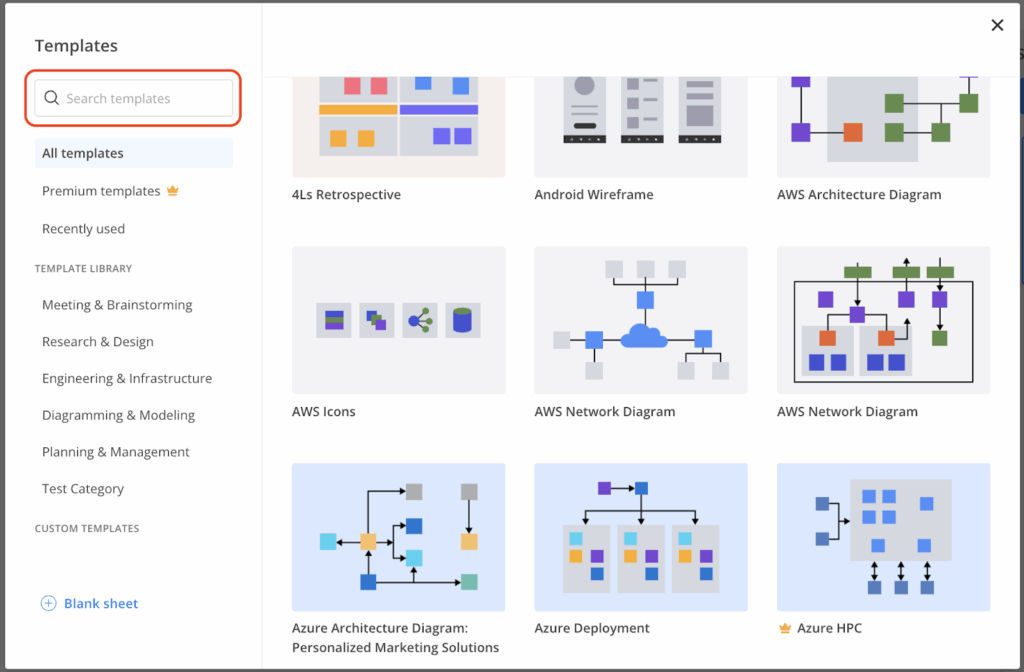
To preview a template, hover and click “Preview.” To use it, click “Use template.”

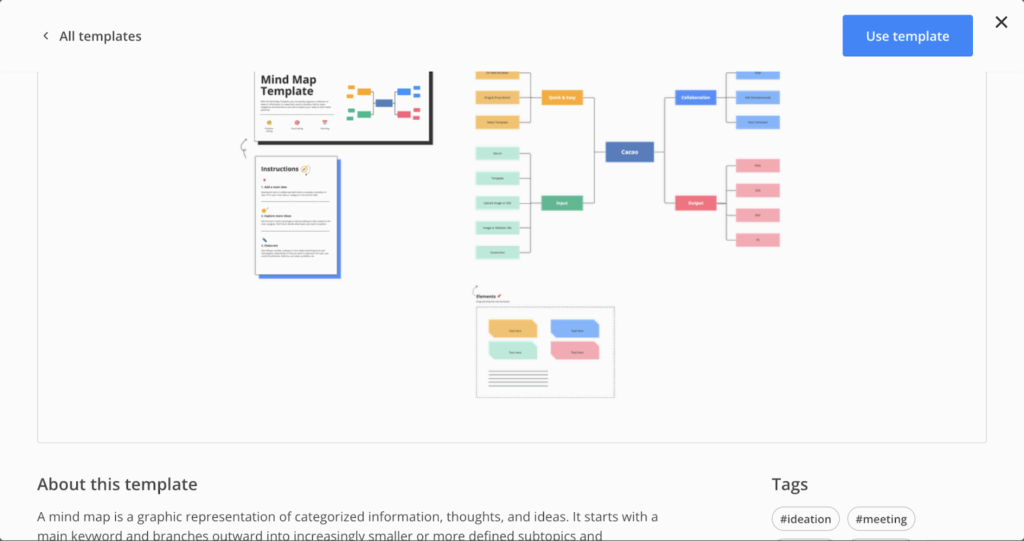
Depending on where you launch it, Cacoo will either:
- Start a new board (from the dashboard), or
- Add it to the current or new sheet (from within the editor).
Adding multiple templates
Want to combine multiple systems, layers, or flows in one board? Cacoo supports adding multiple templates:
- Single-page templates are added to the right of the current content.
- Multi-page templates can begin on a new sheet.
Use this feature to build layered architecture diagrams or create system overviews with modular components.
Editing templates
All templates are fully customizable.
- To edit: Select or double-click an object.
- To unlock: If you see lock icons, select the object and click “Unlock” in the editor menu.
- To modify components: Add, delete, or rearrange shapes and text as needed.
- To keep consistency: Use Cacoo’s alignment guides and style tools.

Editing a template via the drag-and-drop tool
Many templates also come with extra reusable objects and notation kits in a side panel — perfect for expanding your board without starting from scratch.
Creating custom templates
If your team frequently reuses the same layouts, creating a custom template can save serious time.
How to save a custom template:
- Open your board.
- Click the arrow next to the board title.
- Select “Set board type” > “Template.”
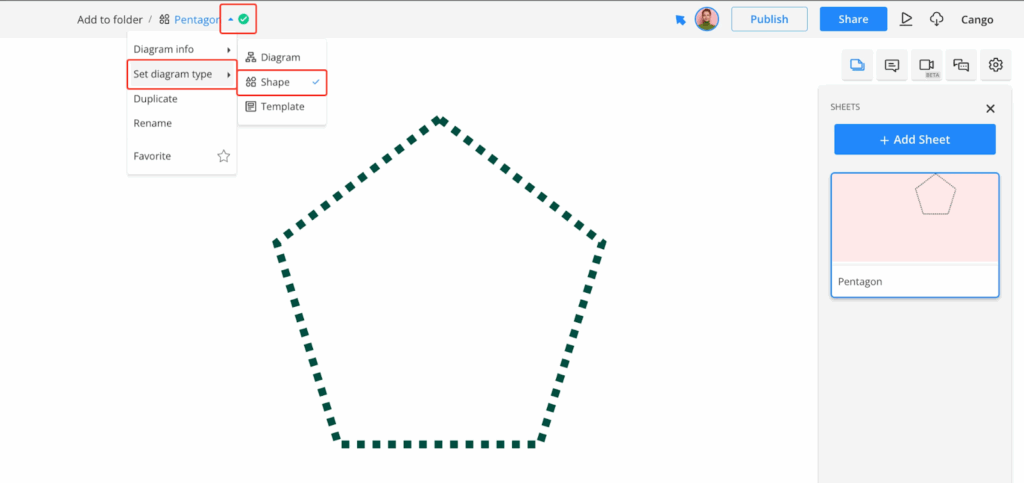
- Hit the “Publish” button at the top right.
Your template will appear in the “Custom templates” section of the library.
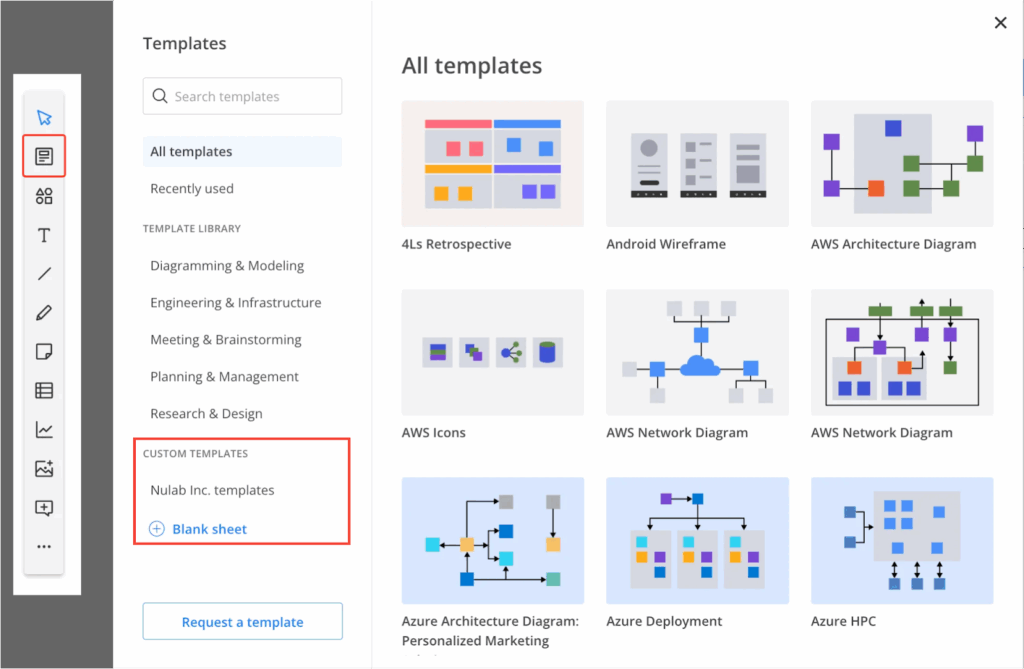
Note: Blank-sheet boards won’t be labeled as templates unless you add content.
Updating a custom template
If you make changes to a custom template diagram:
- Click “Publish” again to update it in the library.

- Cacoo autosaves boards — but not template updates unless you manually publish.
Removing a custom template
There are two ways to remove a saved template:
- Archive the board
- Change its type
Use the top nav dropdown to switch it from “Template” to “diagram.”
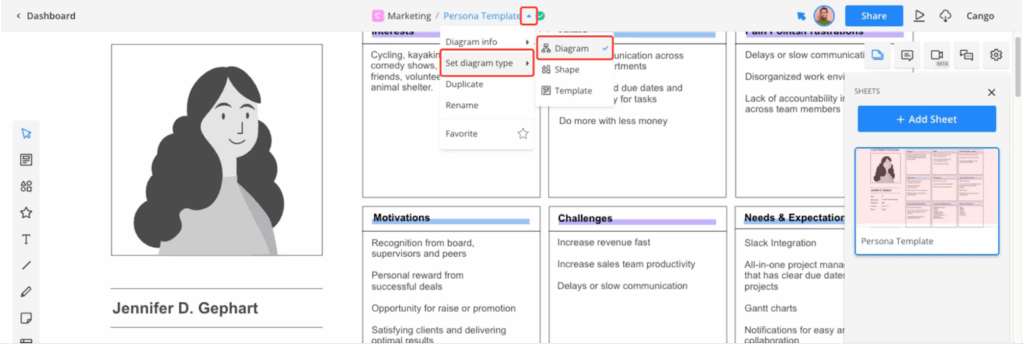
Best practices for development diagrams
Want your diagrams to be clean, shareable, and dev-team ready? Here are a few pro tips:
1. Define your goal first
Are you mapping infrastructure? Modeling a system? Sharing with stakeholders? Knowing your end goal helps shape structure and styling.
2. Use consistent naming conventions
Stick to naming schemes like Team_Project_Layer_YYMM to stay organized.
3. Keep it clean and scannable
Structure diagrams left-to-right or top-to-bottom. Use white space and grouping to separate concepts.
4. Stick to visual standards
Use 2–3 colors, one font, and clear icons. This helps make even complex systems easier to digest.
5. Collaborate in real time
Need feedback? Invite teammates via “Share,” set permissions, and chat directly in the diagram with built-in video.
Getting started with Cacoo
For development teams, clear diagrams go way beyond pretty pictures. They’re essential for problem-solving, good documentation, and helping everyone understand the plan, no matter what their discipline. With Cacoo’s templates, you can:
- Kickstart your architecture, ER, or UML diagrams in seconds
- Customize visuals for your systems and stacks
- Collaborate and present without switching tools
- Reuse your best work with custom templates.
So whether you’re documenting a legacy system or mapping out your next microservice, Cacoo helps your team move faster, communicate better, and stay in sync.
Explore the Cacoo template library and create your first dev-ready diagram today!


